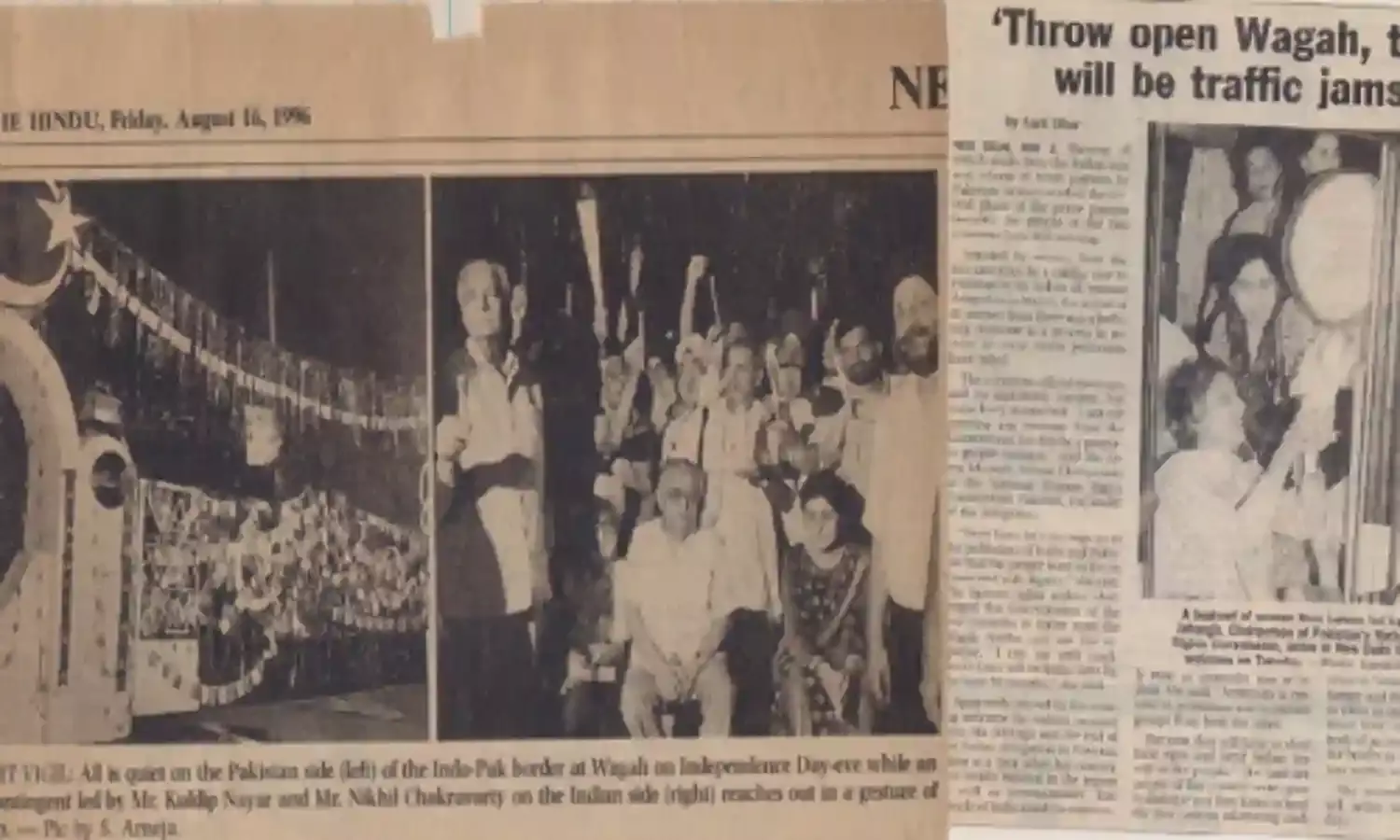For a Day And a Night Open the Gates of Wagah: Kuldip Nayar, Asma Jahangir
A dream and a legacy

For a day and a night the gates either side of the Wagah border should open. This is the dream of many who have struggled the past three decades against strong contrary currents.
Kuldip Nayar and Asma Jahangir, two authors of this dream, gave their lives to bonding Pakistan-India relations. In many forums they floated these thoughts. For 24 hours ordinary people, Indians and Pakistanis without SAARC stickers or diplomatic passports, should be able freely to walk across and mingle with one another, with one overwhelming emotion, to commemorate the ideals of these two Safiraan e Aman or Emissaries of Peace.
I raised this idea in an article I wrote on August 22, 2018, holding back tears, the day Kuldip ji died. Yesterday morning while rushing for a flight I saw a man who I had always identified with Kuldip. It was the one and only Hans Raj Hans. 'Hans Raj ji will you come to Wagah border if we hold an open-gate meeting to honour Kuldipji and Asmaji?' I asked this beautiful man whom I had seen in the year 2000 at midnight, performing at Wagah before an audience of 10,000 fans on this side and hundreds on the other, glued to the border posts.
Hans placed a hand on his heart and spoke just three words. 'Taa umr haazir' (So long as I am alive I will be there). More tears!
I found two newspaper clippings in my precious archive, both from The Hindu. The first dated August 16 1996, is a photograph of Kuldip Nayar and Nikhil Chakravarty at the Wagah border holding candles. I saw myself seated next to Nilkhil. The second photograph, dated May 3, 2000 shows Asma at the open door of the bus Paigham e Aman, poised to release a ‘Pakistani’ pigeon into Indian skies.
The Bus had just driven in to the Ambedkar Bus Terminal from Lahore. It was filled with Pakistani women who had come to Delhi in response to a similar Bus with Indian women that had gone to Lahore two months earlier. The second women’s Bus was to arrive from Lahore the next day. All three had just one slogan, one agenda: Goli nahin Boli, Yudh nahin Shanti (Not bullets but dialogue, Not war but peace).
The first words Asma spoke as she stepped onto Indian soil were, ‘From here let a message go to the politicians of India and Pakistan that the people want to live in peace and with dignity.’ She then challenged the governments of both countries to throw open the Wagah border and see the response of common people. ‘I can say with confidence there will be traffic jams.’
Since they were captured on camera, these two images have remained etched in the minds and hearts of a generation of people from both countries. This is why year after year Punjab has taken the lead in the candlelight vigil in which people from across the country have joined. It is why after this initial effort by WIPSA (the Women’s Initiative for Peace in South Asia) started by beloved Gandhian Nirmala Deshpande and the fiery crusader Mohini Giri, many other groups, prominently WISCOMP (Women in Security, Conflict Management and Peace) and the Women's Regional Network have taken it forward.
Could these forces prevail upon the leadership of both countries, one old one new, to once again give peace a chance. On the Pakistani side there is a new president and a new prime minister who can carve a new path, as indicated by Imran Khan in his first speech. On the Indian side Prime Minister Modi can emulate his mentor Atal Bihari Vajpayee who boarded the Bus to go across the border and offer his respects at the Minar e Pakistan.
There is a buzz about opening the corridor from Kartarpur to Gurdaspur. The distance between the two Gurdwaras Darbar Sahib Kartarpur in Narwal and Dera Baba Nanak Sthal in Gurdaspur is four kilometers. Guru Nanak’s 550th Jayanti will be celebrated in November next year. What greater gift than open access to Sikhs from here to visit the spot where their founder breathed his last?
The distance between the two borders at Wagah is 50 meters and peace between the two countries is also a pilgrimage.
Kuldip Nayar along with his friend and fellow traveler Rajinder Sachar was the last of the breed who experienced 1947. It was their compatriots on both sides of the border who inspired the poet Raees Amrohvi (himself one such) to write these lines, which are the anthem of displaced people. Mani Shankar Aiyar translated the poem during his days as diplomatic counsel in Karachi.
Here is one immortal stanza:
Kya hum bhula sakeinge
Ajdaad key watan ko
Bhooli hui fiza ko bisrey huey chaman ko
Ganga ki dilkashi ko Jumna ke bankpan ko
Maazi ki suhbaton ko yaaron ki anjuman ko
O Hind ke musafir soz-e-kalaam leja
O Hind jane waley mera salaam leja
Can we ever forget so
The earth of our ancestors?
The wind which wafts in memories
Of brothers and of sisters,
The gurgling of the Ganga
The Yamuna swirling fast,
The friendships of our younger days,
Dalliances of the past.
Oh! You who go to India
Affection fills our yearnings,
Oh! You who go to India
Carry to them our greetings.
Towering Kuldip and diminutive Asma, both firebrands, kept up the struggle despite, despite!
The need now is for we the people of both countries to stand up and speak for India and Pakistan in the same unafraid breath. Let the demand for open gates become a nation's call.


